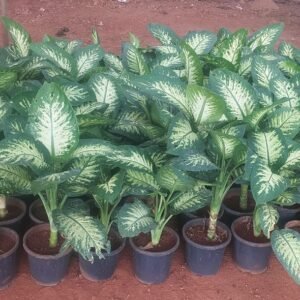Biocolor Tikoma, also known as Biocolor Hoya, is a captivating and vibrant variety of the Hoya plant, renowned for its stunning foliage and unique coloration. This tropical vine is a favorite among plant enthusiasts due to its striking appearance and relatively easy care requirements, making it an ideal choice for both novice and experienced gardeners. With its colorful leaves and potential for fragrant blooms, Biocolor Tikoma brings a delightful touch of the tropics to any indoor or outdoor space.
Appearance
Biocolor Tikoma is characterized by its lush, waxy leaves that showcase a delightful mix of colors, typically featuring shades of green, cream, and pink. The unique variegation patterns create an eye-catching display, with the vibrant hues often becoming more pronounced when the plant is grown in bright, indirect sunlight.
The leaves are thick and succulent, which is a hallmark of the Hoya genus. This adaptation allows the plant to store water, making it drought-tolerant and able to thrive in a variety of indoor conditions. Additionally, Biocolor Tikoma may produce clusters of star-shaped flowers that are typically white or pale yellow, often with pink or red undertones. These blooms, while not the primary attraction of the plant, add an enchanting aroma and a touch of elegance during the blooming season, attracting pollinators like bees and butterflies.
Growth Habit
As a climbing or trailing vine, Biocolor Tikoma can grow several feet long, making it perfect for hanging baskets, trellises, or as a cascading plant in containers. Its growth habit allows it to thrive in various settings, whether you want to create a vertical garden or add a touch of greenery to your shelves.
Cultivation and Care
Caring for Biocolor Tikoma is relatively simple, making it suitable for various plant enthusiasts. Here are some essential tips for successfully growing this beautiful plant:
- Light: Biocolor Tikoma thrives in bright, indirect light. While it can tolerate lower light conditions, providing adequate light will encourage vibrant leaf coloration and promote flowering. Avoid direct sunlight, as it can scorch the leaves.
- Soil: A well-draining potting mix is crucial for Biocolor Tikoma. A blend of potting soil, perlite, and orchid bark provides the necessary drainage while retaining some moisture.
- Watering: Water the plant when the top inch of soil feels dry. Biocolor Tikoma prefers slightly moist soil but can tolerate brief periods of drought. Be cautious not to overwater, as this can lead to root rot.
- Humidity: This tropical plant enjoys higher humidity levels. If grown indoors, consider misting the leaves or placing a humidifier nearby, especially during dry seasons. Grouping plants together can also help create a more humid microenvironment.
- Temperature: Biocolor Tikoma thrives in temperatures between 65°F to 80°F (18°C to 27°C). Protect the plant from cold drafts and sudden temperature fluctuations, as it is sensitive to extreme cold.
- Fertilizing: During the growing season (spring and summer), feed Biocolor Tikoma with a balanced, water-soluble fertilizer every 4 to 6 weeks to promote healthy growth and vibrant foliage. Reduce fertilization in the fall and winter when the plant’s growth slows.
Uses and Benefits
Biocolor Tikoma is not just an attractive plant; it also offers several benefits:
- Ornamental Value: With its stunning variegated foliage and cascading growth habit, Biocolor Tikoma makes a striking focal point in homes, patios, or gardens. It can be used in hanging baskets, vertical gardens, or as a trailing plant on shelves.
- Air Purification: Like many houseplants, Biocolor Tikoma can help improve indoor air quality by filtering out toxins and releasing oxygen, contributing to a healthier living environment.
- Low Maintenance: With its relatively low care requirements, Biocolor Tikoma is an excellent choice for busy individuals or those new to indoor gardening.
Common Issues
While Biocolor Tikoma is generally resilient, it can encounter some common challenges:
- Pests: Keep an eye out for common pests such as spider mites, mealybugs, and aphids. Regular inspections and prompt treatment can help keep the plant healthy.
- Leaf Drop: Sudden leaf drop can occur due to environmental stress, such as overwatering or insufficient light. Monitoring the plant’s conditions and adjusting care practices can help restore its health.
- Fungal Issues: Excess moisture on the leaves can lead to fungal problems, such as leaf spots or powdery mildew. Ensure good air circulation around the plant and avoid overhead watering to minimize this risk.






Reviews
There are no reviews yet.